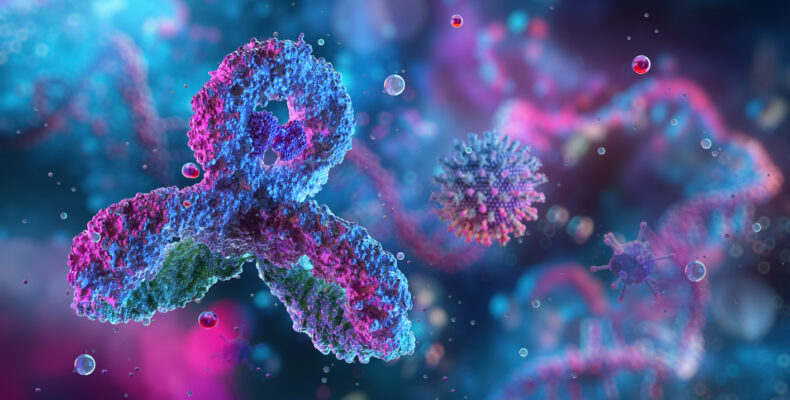
Patenting antibodies in Europe and beyond: a comparative guide to the IP5
A Briefing Paper
Antibodies and their derivatives, including bispecific and multispecific antibodies, fragments, and fusion products, have become central to modern biotechnology. Given their significant commercial and medical importance, particularly in therapeutics and diagnostics, effective patent protection is essential. However, patentability requirements for antibodies vary significantly across jurisdictions.
This briefing paper aims to summarise the intricacies of European patent law for obtaining patent protection for antibodies and their derivatives, where relevant legal references are cited to help support strategic decision making.
Comparative insights into the practice of the US, as well as China, Japan, and South Korea – the patent offices for which, in addition to Europe, are collectively known as the IP5 – are also provided to aid applicants patent antibodies worldwide.
Patenting antibodies in Europe
Structural vs functional claiming
Under the European Patent Convention (EPC) an antibody must satisfy the core requirements of Article 52 EPC to be patentable, i.e. it must be novel (new), have an inventive step (not obvious to devise; discussed in more detail below in relation to Article 56 EPC), and have industrial applicability (practical and tangible use in industry).
The European Patent Office (EPO) currently strongly favours claims – which define the scope of protection sought for an invention – that disclose an antibody by its structural features. In this respect, per the current EPO Guidelines for Examination (Part G, Chapter II, Section 6) an antibody should be claimed via:
- At least its complementarity-determining regions (CDRs), which enable specific antigen binding (wherein all six CDRs should be claimed unless it is shown that one or more does not interact with an antigen); but
- Preferably its full amino acid sequences (e.g. heavy [VH] and light [VL] chain variable regions).
Rather than stating the exact amino acid or nucleotide sequences defining the structural features of the antibody, a claim may also refer to variability in the sequences (generally referred to as ‘sequence identity variability’). However, EPO examiners are increasingly looking unfavourably upon this practice, especially without experimental evidence to support such variability or if sequences are not combined with a clear functional feature.
Further, if CDRs are not defined by their specific sequences but by reference to a larger heavy or light chain sequence, the numbering scheme for CDR assignment such as the Kabat, Chothia, or IMGT scheme must be indicated. Again, this appears to be an increasingly common request amongst EPO examiners (and numbering schemes are now referred to in the Guidelines).
Defining an antibody by CDRs alone has also become increasingly difficult at the EPO, where framework sequences are considered crucial to antibody binding characteristics in addition to CDRs. Without significant data demonstrating that the framework can be varied for a given set of CDRs whilst retaining function, claims are more likely to be limited to full VH and VL sequences.
Thus, if claiming an antibody or derivative, applicants may need to limit to specific structural characteristics, narrowing the scope of protection sought. However, it may be possible to retain reference to broader structural features if claimed in combination with functional features such as desirable potency characteristics achieved in a relevant biological assay.
Alternatively, an antibody may be claimed only by reference to its functional features, such as its ability to bind to a new target antigen (e.g. “An antibody that binds antigen X”) or epitope (i.e. the structurally defined part of the antigen that the antibody specifically binds to).
It is also possible to define an antibody by its ability to bind to a well-defined antigen in combination with a negative feature, for example, “An antibody capable of binding to antigen X and not to antigen Y”, or based on its target antigen plus functional features defining other properties such as its neutralising properties, or ability to induce apoptosis or activate/inhibit certain receptors.
However, claims purely defined by binding properties are only allowable if the antigen is clearly defined and supported by sufficient evidence (usually in the form of experimental data) to show that antibodies with those properties cannot be routinely generated.
Note also that claims directed to a method for producing the antibody (or the hybridoma used to generate the antibody) and the nucleic acid sequences encoding the antibody are permitted.
Sufficiency of disclosure
In addition to Article 52 EPC, an antibody must also meet the requirements of Article 83 EPC in that it must be described clearly and in sufficient detail in the application for a person skilled in the art to make and use it without needing further inventive skill or undue effort (referred to as ‘sufficiency of disclosure’).
Under Article 83 EPC, where the invention relates to one or more antibody, this typically requires at least one example of an antibody that has been fully characterised and a description of how additional antibodies with similar functions can be obtained (if claiming more than one antibody).
This requirement was established in T 409/91 in that a disclosure must enable the skilled person to carry out the invention over the entire scope claimed (i.e. for all claimed antibodies and not just for one or two). This is also set out in the Guidelines (e.g. Part F-III, Section 3 and Part G-II, Section 6.1).
In other words, functional definitions such as claiming an antibody via reference to its target antigen are allowable only if the skilled person can identify antibodies without excessive trial and error (T 735/00). Though an antibody may also be claimed via reference to its epitope, this feature is not normally deemed sufficient for antibody identification.
Further, though in principle the EPO allows an applicant to submit experimental evidence after the filing date of an application – known as ‘post-filed’ or ‘post-published’ data – to support a technical effect for a claimed antibody (which may be necessary if it was not possible to obtain enough data before filing), as handed down in the much-anticipated Enlarged Board of Appeal decision G 2/21, such data may only be relied upon if the following is met:
“…the proof of a claimed therapeutic effect must be provided in the application as filed, in particular if, in the absence of experimental data in the application as filed, it would not be credible to the skilled person that the effect is achieved. A deficiency in this respect cannot be remedied by post-published evidence.”
Thus, applicants should be aware that if the application does not disclose the claimed one or more antibody in sufficient detail, post-filed data cannot remedy a lack of sufficiency, and such speculative applications are likely to be dismissed.
Inventive step
Per Article 56 EPC, inventive step is assessed against the closest prior art (such as a publicly available document that discloses a very similar antibody to that claimed). However, due to the prevalence of antibody filings the guidelines now have a dedicated section (Part G-II, Section 6.2) that aims to provide guidance on achieving an inventive step for antibodies.
Per the Guidelines, novelty alone, even when structural differences are identifiable from prior art antibodies, is not sufficient to argue that a new antibody has an inventive step. Antibodies produced by standard methods (e.g. hybridomas) will also be considered obvious unless unexpected or surprising properties are shown (T 1466/05).
Applicants should therefore highlight clearly any unexpected technical effects, such as enhanced specificity or therapeutic efficacy, to support a claim to inventiveness. Applicants should, however, note that improved binding affinity is unlikely to render a claimed antibody inventive over known antibodies since affinity maturation is considered routine in the art, unless it is a significant improvement to affinity at levels that may be difficult to achieve for a given target, and if it can be established that the enhanced binding would lead to an improved therapeutic outcome.
An antibody may also be considered inventive if the application shows that technical difficulties in generating or manufacturing it were overcome, or if a novel type of functional antibody format is devised. Essentially, any advantageous feature could be used for inventive step, such as novel modifications leading to enhanced stability in formulation, enhanced PK/PD, or reduced immunogenicity.
Further, G 2/21 made clear that for post-filed data:
“…a patent applicant or proprietor may rely upon a technical effect for inventive step if the skilled person, having the common general knowledge in mind, and based on the application as originally filed, would consider said effect as being encompassed by the technical teaching and embodied by the same originally disclosed invention.”
The gold standard for overcoming a prior art antibody is the provision of comparative data showing that the claimed antibody provides a significant advantage (i.e. technical effect) over the prior art antibody, which may be in the form of in vitro or in vivo data. However, it is often difficult to predict which comparative test should be provided. Accessing or recreating prior art antibodies for such tests can also be difficult. Therefore, applicants should include as much data as possible in the application at the time of filing, ideally using a varied range of useful comparators, to reduce the likelihood of needing to rely on an undisclosed (or “credible”) technical effect via post-filed data.
Negative data showing antibody panel members that have been generated that do not function well in a given assay/model can also be valuable to demonstrate that the claimed antibody is special, and that not just any antibody that binds to the same target (like a prior art antibody) can provide the proposed technical effect. Such data could be used as a substitute for direct comparative data, which may not be available.
Claim formats
If wanting to claim a therapeutic use for an antibody, methods of treatment (e.g. “A method of treating cancer comprising administering antibody X to a subject”) are not permitted as they are viewed as being performed on the human or animal body, which is not allowable subject-matter in Europe.
However, allowable medical use claims can be provided in the form of “Antibody X for use as a medicament” and “Antibody X for use in the treatment of disease Y”.
New medical uses of a known antibody for treating a disease can also be claimed in a second medical use format (e.g. “Antibody X for use in treating cancer”). So-called ‘Swiss-style’ claims in the format of “Use of a substance X in the manufacture of a medicament for the treatment (or diagnosis) of [disease]” were abolished from the Guidelines in 2010.
Methods of diagnosis, so long as they are not performed on the human or animal body (e.g. by specifying the use of a sample), are allowable.
Patenting antibodies in the US
The United States Patent & Trademark Office (USPTO) has historically allowed broader, functionally defined antibody claims, especially when an antigen is newly identified.
However, following the decision handed down in Amgen Inc. v. Sanofi (2023), where the US Supreme Court held that merely describing the function of an antibody without describing a representative number of species across the full scope of the claims is insufficient, there has been a tightening of the enablement requirement under 35 U.S.C. 112(a) (equivalent to Article 83 EPC).
This ruling aligns US practice more closely with that of Europe by requiring applicants to structurally define antibodies and demonstrate that the skilled person (referred to as the ‘skilled artisan’ in the US) can reasonably put into practice based on the information provided in the application the full claimed genus of antibodies. The disclosure of VH and VL sequences is also now routinely necessary based on our experience of US practice.
However, functional claims are still viable in the US if they are backed by sufficient representative examples and predictable structure-function relationships.
Under US patent law, an antibody considered novel is also automatically deemed to be non-obvious i.e. have an inventive step. This principle is referred to as ‘structural non-obviousness’, where it is granted that a new antibody with a distinct structure compared to known antibodies is non-obvious and therefore patentable even if the new antibody performs the same function as the antibodies of the prior art (35 U.S.C. 103).
This is because the USPTO views sequence differences as evidence of an inventive step as they are not derivable just by routine optimisation of the antibody. Thus, arguing an antibody is both novel and non-obvious in the US may be easier to achieve compared to the stricter requirements for inventive step in Europe.
The therapeutic claim formats permitted in the US include methods of treatment involving direct administration of therapies to patients. Methods of diagnosis (even if practised on the human body) are also patentable in the US, but they can be difficult to achieve if they merely amount to measuring a natural phenomenon, such as the presence or level of a biomarker. This is due to rejections based on so-called ‘laws of nature’ being patent ineligible subject-matter (under 35 U.S.C. 101). However, there are some exceptions, and diagnostic methods under certain criteria may be allowable.
Post-filed data is also generally accepted by the USPTO and can be used to support non-obviousness such as an unexpected technical effect, commercial success, or longstanding unmet need. Its use is particularly powerful if submitted as part of a declaration (i.e. a sworn statement submitted after the filing date of an application to provide further evidence or information that wasn’t available at the time of filing). Though post-filed evidence can be used to support the enablement of the original disclosure, it cannot be used to remedy a complete lack of enablement.
Patenting antibodies in other major jurisdictions
China, Japan, and South Korea have much overlap in their requirements for patenting antibodies. Like Europe and the US, these jurisdictions require that an antibody is novel, inventive, and has industrial applicability. In addition, sufficiency of disclosure is key.
Generally, an antibody to a new antigen will be accepted so long as the antigen is structurally defined and its function established. Where the antigen is known, China, Japan, and South Korea generally require that a claimed antibody targeting a known antigen is structurally defined (via its six CDRs or VH/VL regions, for example).
China
The China National Intellectual Property Administration (CNIPA) favours structural definitions and tends to align with European practice but may be stricter in some circumstances. Per the CNIPA Patent Examination Guidelines and Patent Law of the People’s Republic of China, applicants must disclose at least one antibody sequence or hybridoma deposit (under the Budapest Treaty) and reproducible methods for obtaining functionally similar antibodies.
Functional claims may be accepted if accompanied by solid structural disclosure and reliable experimental data, but claims purely directed to “An antibody that binds antigen X” without further disclosure are typically rejected owing to an application’s lack of support for such claims.
Thus, the CNIPA often takes a stricter approach than that of other jurisdictions including Europe, and in reality examiners generally require that an antibody is claimed by both its structural features (e.g. its six CDR sequences or VH/VL regions) as well as its target antigen. Experimental data showing functionality of all homologous proteins is required (Novo Nordisk vs. Longda Co.and Boli Co., Civil Judgments (2012) No. 41 and 42, Tianjin H. People’s Ct.). In our experience, Chinese examiners routinely review in detail the experimental evidence provided in the example(s) of an application and require claims to closely align with such evidence.
Like Europe and unlike the US, structural non-obviousness per se may be insufficient to establish patentability in view of other known antibodies. For an antibody to be considered non-obvious at the CNIPA, unexpected technical effects such as enhanced binding affinity and activatory/inhibitory activity must be demonstrable in the application.
Though methods of treatment/diagnosis or second medical use claims are not permitted, Swiss-style claims are. Post-filed data may also be accepted by the CNIPA but is generally only used to further argue industrial applicability or inventive step (provided any technical effects are already disclosed in the application as filed) and will be difficult to rely upon to remedy a lack of sufficiency.
Japan
The Japan Patent Office (JPO) traditionally notes that a claim directed to an antibody may be defined by specifying the antigen it targets, the hybridoma that produces it, or by cross-reactivity with another antibody (Examination Guidelines for Patent and Utility Models in Japan and the Patent Act of Japan).
The practice of the JPO is thus generally considered more aligned with Europe than other jurisdictions. Applicants must also demonstrate that the skilled person could generate the claimed antibodies without excessive trial and error, but if adequate support is provided epitope-defined claims may be accepted.
Like Europe and China, it is generally necessary to demonstrate unexpected properties for a claimed antibody or that challenges were overcome in obtaining the antibody (especially if well-known or routine methods are used) for the JPO to acknowledge that an antibody is inventive (Glaxo Group Ltd. v. Commissioner Japan Patent Office, Heisei 15 (Gyo-ke) 104, 2003 (Tokyo H. Ct.)).
Advantageously, the JPO also permits the inclusion of multiple claim formats in a single application, offering further strategic flexibility. Allowable formats include Swiss-style and second medical use claims, as well as method of treatment or diagnosis claims (though these must be directed towards animals, not humans).
Like Europe, though post-filed data is accepted by the JPO its use is restricted for arguing a purported technical effect to demonstrate inventiveness. As the JPO requires that the application contains data relating to a claimed composition (Astellas & Fujisawa v. Commissioner Japan Patent Office, Heisei 17 (Gyo-ke) 10312, 2005 (Intellectual Property H. Ct.)), post-filed data cannot be used to remedy a complete lack of support under Japanese law.
South Korea
As in Europe, antibodies defined structurally are more likely to be accepted under the Korean Patent Act at the Korean Intellectual Property Office (KIPO). However, antibodies defined functionally are scrutinised more closely. Like China and Japan, the KIPO requires that an antibody is claimed by its sequence(s) unless its target antigen is novel, in which case the antibody can be defined by the target sequence.
If only functional features are provided, applicants must supplement this by including in the application at least one working example, sequence information, and ideally experimental data for the claimed antibody, to enable reproducibility by a skilled person. The specific means of production of the antibody (e.g. hybridoma) and the activity of the antibody must also be disclosed to meet sufficiency requirements (1998 Won 3919).
Like Europe, antibodies against known antigens may not be considered inventive unless the applicant can show unexpected or surprising technical effects, such as improved specificity or therapeutic utility. Structural non-obviousness per se is insufficient in this respect and technical significance should be specified in the application (1998 Won 2040; 2000 Her 297). Like China, KIPO examiners tend to grant subject-matter in line with the specific disclosures in the examples.
Korean practice is also aligned with European practice in that claims directed to new therapeutic uses of known antibodies are permitted. A specific disease must be recited, even if “Antibody X” is a new antibody. Method of treatment and Swiss-style claims are not accepted by the KIPO, but like at the JPO, methods of diagnosis are permitted if performed directly on the animal body (humans must be excluded).
Further, though the KIPO accepts post-filed data, typically such data will only be accepted to argue inventiveness and is less likely to be accepted to argue sufficiency. However, unlike Europe, China, and Japan, post-filed data can be used to establish enablement.
Strategic takeaways
Overall, patenting antibodies requires navigating complex and evolving legal requirements. To maximise protection across jurisdictions, applicants should consider:
- Disclosing full sequences to VH/VL regions or at least CDR sequences;
- Providing varied robust binding, affinity, and therapeutic evidence. The inclusion of comparative data showing the improved performance of the claimed antibody over e.g. the gold standard in the field or the antibody with the closest structural similarity will also provide a significant advantage if such data is included in the application;
- Using multiple claim formats comprising structural and functional features, especially if uncertain as to where to pursue protection worldwide;
- Filing divisional applications in Europe and other jurisdictions where permitted to try preserve broader structural and/or functional claims;
- Pursuing marketing approval for specific indications, with careful consideration given to non-patent exclusivity measures such as regulatory data exclusivity as well as other opportunities to extend patent protection via supplementary protection certificates or patent term extensions.
Ultimately, strategic planning supported by robust experimental data and clear claim drafting, in light of ongoing reviews to local patent law requirements and regulations, remains essential for global antibody patent protection.
Finally, though this briefing paper aims to summarise the varying practice for patenting antibodies and their derivatives across the IP5, applicants should always consult with attorneys local to each jurisdiction to obtain accurate and current advice.
Barker Brettell has a dedicated medical sector team who can assist and advise you on how to achieve the best protection for your innovation. To continue the conversation, please contact the authors of this article, Laura Riggall and Jonathan Myers, or your usual Barker Brettell attorney.
Published: July 2025




